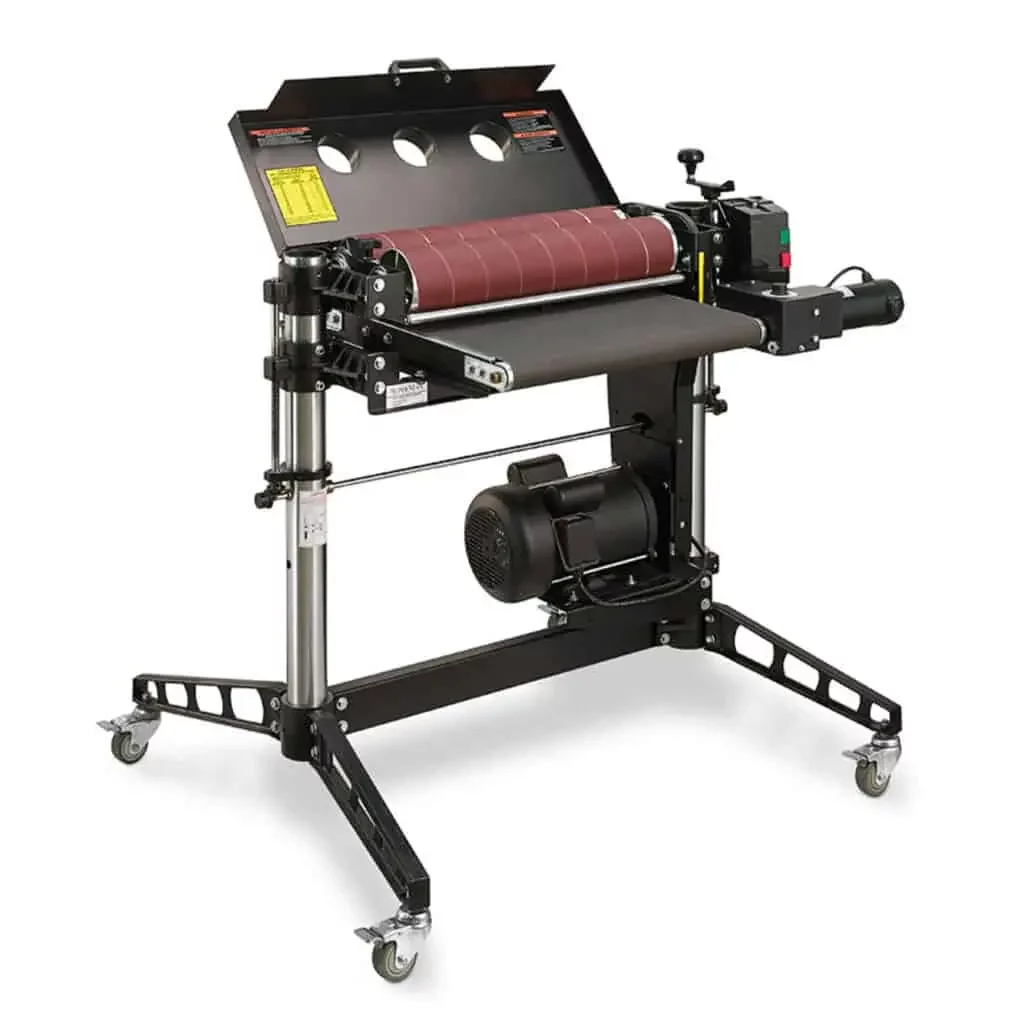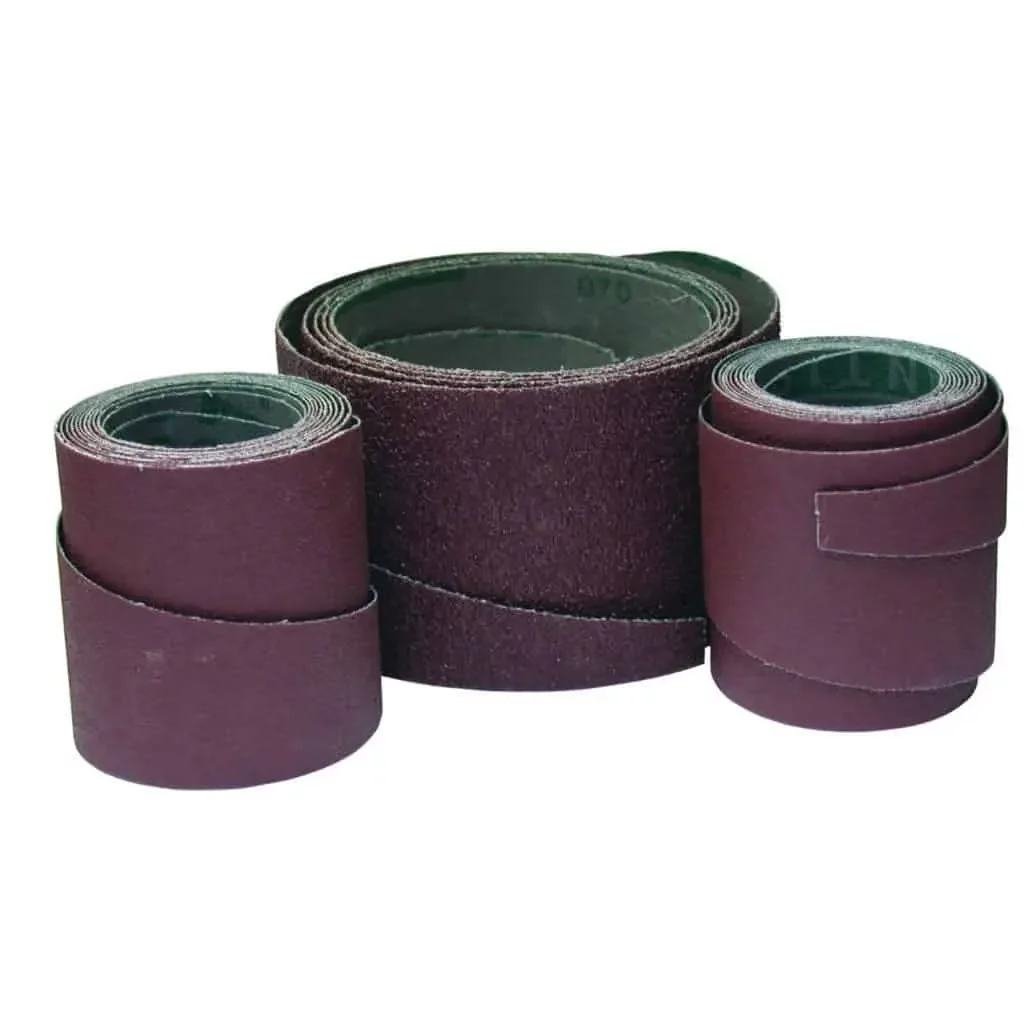You don’t need to call in the pros to clean your drum sander paper. No, you don’t need to buy a special paper cleaner. No, you don’t need to do anything other than toss old paper with a new one, lay it flat on a flat surface, and lightly run your beater over it before loading your sander. Let’s explore how to clean drum sander paper in detail.
- Fill a bucket with a mild solution of Simple Green and water, and drop the rolls in for 1/2 hour.
- Clamp them to a 2×4 using spring clamps. Get a stiff bristle brush, and scrub them down.
- Leave them clamped to the 2×4 to dry. When using a vacuum, follow the steps below.
Start by bringing a vacuum attachment. Regardless of using a bench or floor sander, you can use a vacuum attachment when cleaning sanders. These sanders integrate with vacuum cleaners too.
They accept these dust containment systems, as you can use the vac to suck up sawdust. There will not be a lot of sawdust flying around when you work, meaning a cleaner working environment and fewer clogs.
The system works with a dust bag used to collect the dust before disposal. Vacuum cleaners reduce the dust but not eliminate it. Inspect the drum sander and employ other cleaning techniques.

Schedule for paper cleaning. The vacuum cleaner does not eliminate dirt. For better results, clean the paper. Residue accumulates on the sanding paper sheet or the belt.
Remove this built-up residue with a rubber-like eraser. Press the hard rubber on the paper, and then the drum sander is operated. The residue loosens up as the sander starts working, and the vacuum attachment sucks it up.
Always check on the motor brushes. Drum sanders use electric motors that have motor brushes. The motor brushes conduct the electric current between the stationary wires and the moving parts. The brush technology enables the drum sander to collect the dust so easily. The motors are also accessible and require constant care to guarantee better efficiency.
To start cleaning the brushes, open up the motor cap or cover. The cap can be unscrewed and inspected. If the cap is damaged, replace it. If it is in better condition, you can fix it back. Blow out the main brush chamber using compressed air to clean it up. If you find it hard to use an air compressor, get the individual cans that have compressed air.
The cans come with extension tools that make them for tight spaces. Be careful when cleaning brushes since they are attached to a delicate spring system.
Lubricate moving parts. Lubrication is more like a maintenance tip and a cleaning mechanism. When moving parts are lubricated, they perform better, preventing the system from getting stuck.
Oil moving parts that will attract dust and dirt. When doing your routine inspection, always inspect the lubricated bearing load sections to ensure no excessive dust build-up. If there is, do a quick wipe using a dry, clean rag before applying some replacement lube.
How to clean sanding discs
There are many ways to clean sanding discs, depending on what you can afford and handle. Using an abrasive cleaning stick is easy. An abrasive cleaning stick is a rubberized stick you hold against a sanding belt as it runs through the sander.
Cleaning sticks work on wood, paint, wood finish residue, metal shavings, and any materials that clog sanding belts. They look like large pencil erasers, and they get rid of the clogs on your sanding belts, extending their lives, increasing their efficiency, and improving cuts and finishes.
These are the best method for cleaning sanding belts designed for that purpose. They are easy to use, last a long time, and are much more affordable than constantly replacing belts. You can buy water-alkaline cleansers. Most of them are biodegradable and emulsify the materials clogging your belts, making them easy to remove.
Sanding discs are the part of a sander that does all the hard work (Empireabrasives.com). They only work on materials like resin, wood, and paint, meaning they are not for cleaning metal that has loaded up the sanding belts. Spray the abrasive side of the belts with the liquid cleaner. The solution will emulsify the build-up on the belts. Grab an air hose or compressed air to blast off the gunk.
The DIY sanding belt cleaner
The shoe method is popular for DIYers. You only need old shoes that you can destroy to save some sanding belts. You can use the sole of an old shoe to clean your belts the same way you would use a cleaning stick. Using rubberized products works best at cleaning sanding belts.
A sole made from layers of latex performs better. The material collects and traps a lot of dirt and dust, so they are for cleaning sanding discs and belts. The grinder will tear off enough of the sole to make the shoes unwearable.
How to wrap sandpaper on the drum sander
- Wind the sandpaper so the edge rotates away from the workpiece.
- Secure the sandpaper to the top and bottom of the drum with rubber bands. When the abrasive on the top layer wears out, slip off the rubber bands, cut off the worn section, put the rubber bands back on, and start sanding again.

Drum sander cleaning pad
The cleaning pad removes almost all of the residue. It pulls dust, wood particles, sap, metal shavings, paint, and other abrasive materials. Rub the pad across the abrasive surface to remove dust, crud, resin, and natural build. Use the pad after your sander has been clogged with wood dust or wood resin to return the sanding surface to a like-new condition.
Sanding belt cleaner alternative
Sanding belt cleaners work to clean and dress sanding belts of all grits, freeing the belts of particles that lodge themselves between the abrasive grains, eventually causing a dull cut (Combatabrasives.com). Take an old crepe-soled shoe and use its rubbery tread to clean the clogged sanding belt. It is affordable and easy to use.
How to clean sandpaper sheets
- Start up your power sander and the dust collection system. Wear hearing and eye protection.
- Slowly press the rubber sole of an old sneaker along with the sandpaper.
- Clean sandpaper in seconds, with hot rubber in the air.
Abrasive cleaning stick
Turn on the sander and run the cleaner stick back and forth across the belt surface, covering an inch-wide section at a time. The abrasive will eat away at the cleaning stick and remove the residue between the grit. Keep moving it until all build-up is removed. It works just like pencil erasers.
- Grain and Sheen: Teak Oil versus Danish Oil Uncovered - January 10, 2024
- The Cherry on Top: Crafting the Perfect Cutting Board - January 9, 2024
- Polyurethane Water-Based vs Oil-Based: Choosing the Right Finish - January 8, 2024